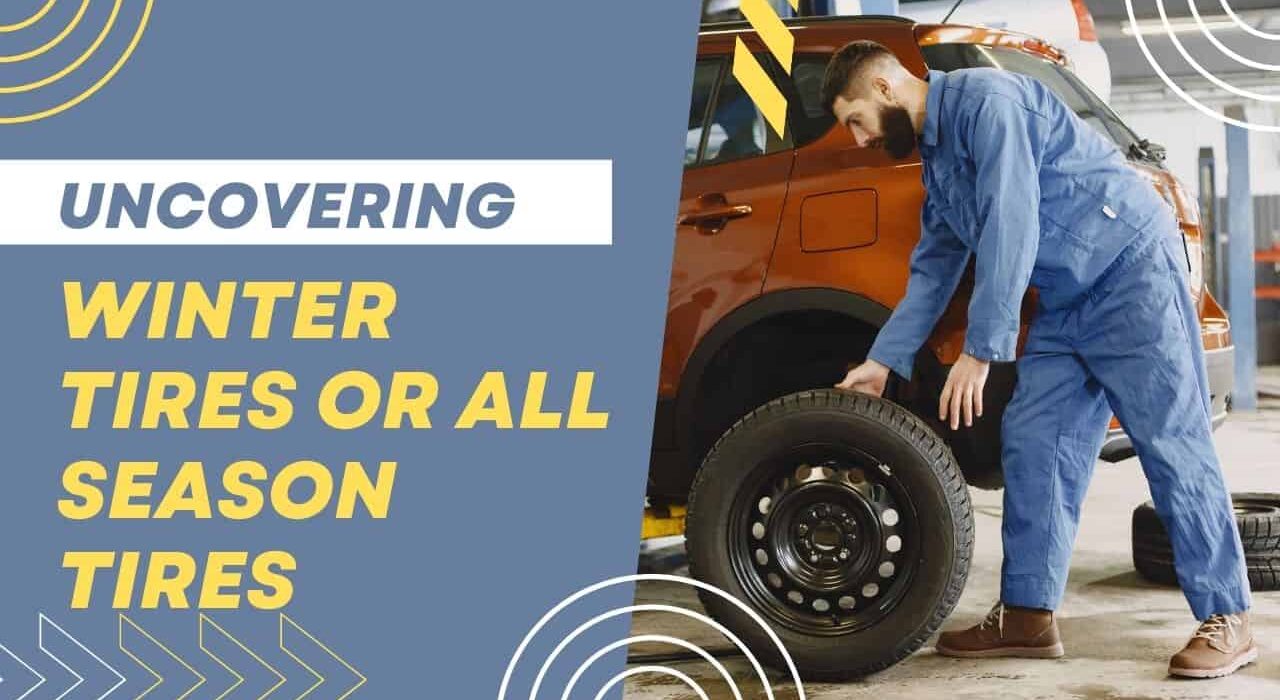A “road test” of the Crossclimate 2 SUVs was conducted by Michelin at an event held at the Porsche Experience Center, which will house four-wheeled entertainment when it opens in September 2021.
The track in Franciacorta was not selected at random; in addition to an off-road course, useful for testing the traction of an All Season tires (or “four seasons”), which is also a proposal for original equipment on some SUVs, the track includes a section with traditional handling exercises and a “zero grip track” that simulates a trip on ice.
Table of Contents
Which is better all season tires or winter tires?
The decision between all season tires and winter tires is influenced by a number of variables, including the types of weather you frequently encounter, your driving style, and your personal preferences.
The performance of all season tires is intended to be excellent in a range of weather situations, such as dry, wet, and light snow. These are a suitable option for drivers who reside in regions with mild to moderate winters because they feature a moderate tread pattern and use a rubber compound that is designed to perform in a range of temperatures. All season tyres are made to offer a quiet, comfortable ride all year long.
On the other hand, winter tires are made expressly for cold and snowy weather. They have a more aggressive tread pattern and a softer rubber compound, both of which are intended to offer improved traction and grip on snow and ice. Drivers who reside in regions with severe winters, including a lot of snow, slick roads, and very low temperatures, are advised to use winter tyres.
Which is better, then? Your driving circumstances and choices definitely matter. All-season tyres might be an excellent option if you reside in a region with mild to moderate winters and little snow or ice. They are typically less expensive than winter tyres and provide decent performance all year.
Winter tyres are perhaps a better option, though, if you reside somewhere with severe winters. They are made to offer the most traction and grip possible in icy and snowy situations, which can be crucial for driving safely. Although while they are more expensive than all-season tyres, they can also increase safety and give you more peace of mind during the winter.
The ideal tyre option will ultimately rely on your unique situation. When deciding between all-season and winter tyres, it’s crucial to take your driving style, the temperature in your location, and your personal tastes into account. A tyre expert can assist you in making the best decision if you’re unclear about which course of action is ideal for you.
WE GIVE THE NUMBERS
Even though winter tyres reached their peak in 2018, Michelin’s analysis of the Italian tyre market from 2015 to 2021 shows that they have lost 14% of their market share overall, with one notable exception: the high-end and higher segments (SUVs and rims from 18 inches and up), where growth has been observed.
The All Seasons, on the other hand, have benefited from an objective improvement in technical performance (more or less consistent across all brands) and have grown so dependable as to be able to defeat just about anyone: in the same period under review, they achieved a growth of +180 %, losing ground due to the pandemic but making significant gains as soon as the travel restrictions were lifted.

What is Money Control App? How Does Moneycontrol App Work? Know All About It In 2024
Moneycontrol app is a new and innovative program that will help you keep track of all your money-making and income earning. With this amazing application,

How To Write a Best Instagram Bio for Girls in 2024?
How To Write a Best Instagram Bio for Girls? Well, I have been looking through a bunch of different Instagram profiles and it is becoming

What is Udaan App? Complete Knowledge Of Udaan App in 2024
Udaan App is an innovative mobile app that enables retailers to monitor their sales, manages their inventory and access vital data regarding their business through
WHY CHOOSE ALL SEASONS
I’ve always been a winter person, so each winter the family cars went through the ritual of getting a new set of tyres mounted on specific rims. This is a good practise for those who want to streamline operations, have enough room in the garage, and don’t mind taking up to an hour to complete the task. It is indisputable that winter tyres function better than any other type of tyre in really difficult winters with a lot of snow.
Over a number of business travels to Italy and Europe, my ancient Juke handled large snowfalls and a few sheets of ice without incident. Do you remember the 4×4 SUVs that get stranded on the side of the road going uphill? They almost definitely attach summer tyres believing they can rely on four-wheel drive, forgetting that a 4×4 cannot function properly without tyre grip.
The few conditions where a winter ski would have performed best, with lots of snow or with temperatures below the “threshold” of 7 degrees, were no longer such as to justify a second set of tyres, the commitment to replace them, and a second set of rims. Over the years, however, I have noticed that the average temperatures began to rise, the winters were less harsh and with less snowfall.
Thus, when I switched to the Model 3 with all-wheel drive, I made the decision to break my own self-imposed rule and drive through the winter with only the summer tyres and chains allowed by law. Crazy? Not entirely: it was the winter of 2021, we were all still unsure of how far the epidemic could really spread, my original Michelin Pilot Sport tyres were wonderful tyres (and they still are after nearly 28,000 km), and saving money wasn’t a bad idea. Hence, the risk/benefit ratio is a concern.
The winter is over, there weren’t many journeys (here’s one from 3° to 12°), and I saw the mountain three times, each time without incident and (nearly) without snow. I won’t deny that I was missing a winter tyre, though, as the crazy hairpin curves in the rain or cold frequently required the use of the four-wheel drive and computer controls. Fortunately, I had superb summer tyres that handled the precipitation very well.
Simply put, I found it difficult to adjust to not wearing the proper footwear. As a result, I drove automatically as though I were on winter tyres before realising that I wasn’t.
The week beginning March 7, 2022, was the most crucial one and the one that made me mourn the winter weather the most. The temperature graph depicts the times when travelling beneath the 7.5° yellow line would have been perfect for winter riders, including stops at more European locations for events like the BMW i4 test, a plenary on batteries at the European Parliament, and a Hyundai test in the snow.
If we consider the cold season as a whole, there are numerous moments for a week, but not too many in terms of absolute value.
MICHELIN CROSSCLIMATE 2 SUV (AND NOT ONLY)
After the exciting Crossclimate 2 SUV introduction, the illumination arrived. The new tyres persuaded me in the practical test split between track and road, which was an evolution of an existing range (this, the “non-SUV” version), which today includes practically all sizes. I had previously driven a rear-wheel-drive Porsche equipped with summer tyres on the low-grip “pistino,” a special variety of perfectly flat asphalt that is remarkably similar to how a car handles on ice.
Due to the fact that the event was still recent in memory, it was even more impressive to observe how the four seasons of Michelin had transformed a track with “zero adherence” into a completely practicable road. On that particular occasion, the goal was to have fun, look for the rear end and the loss of grip. By simply changing the tyres, the ice has changed into a condition similar to wet asphalt for comparison’s sake.
It goes without saying that the test vehicle, a Q5 TFSI-e, is not a sports car. One advantage is that it has all-wheel drive, however it should be emphasised that this feature only aids in traction, not in braking. Also, the Crossclimate 2 SUV’s release elicited reactions that were frank, anticipated, and sincere. The Q5, on the other hand, has the drawback of being an SUV, which forces the tyres to work harder to make up for a high wheel setup when compared to a Porsche.
I frequently make decisions after using something for a review and even realising its shortcomings (my smartphone, my computer, my car, etc.); the same is true for the choice to switch from winter tyres to all-season tyres, which, in the case of Michelin, are also 3PMSF, an acronym that stands for the assurance of being able to travel throughout Europe in the winter without breaking the law.
The good performance of the rubber, which is attested to by the label and confirmed by numerous independent tests conducted by TUV Sud (braking and traction tests) and Dektra (duration tests), also helped to persuade me to make the decision.
The French ones* (asterisk explained in the box below) are the best at maintaining safety performance even at the end of their life, whereas other tyres are excellent when new and degrade exponentially well before the limit of the 2 mm, according to Michelin, who claims that their lifespan is longer.
“Interesting fact: Michelin is currently Italy’s top tyre maker. We’re not just referring to tyres that are actually produced in Italy—Cuneo is one of the best tyre factories in all of Europe—but also to the hired Italians. In other words, a French brand has more of an Italian feel to it than an Italian one”.
The initial test actually confirmed good acoustic performance, which is welcomed in general and even more crucial for people who own an electric or Plug-In SUV, despite the fact that the label refers to B in terms of noise.
It is further evidence of how different today’s “M+S” tyres are from those of the past and how much invisible technology there is as a result of research into the compounds, the casing, and the grooves to see an all-season tyre that has advanced so much that it achieves the same noise level as the Pilot Sport 4 summer tyres (the original equipment ones). And aside from the “Chinese” of the time, this issue generally pertains to all the major producers of high-end tyres.
THE CROSSCLIMATE 2 SUV IN NUMBERS
The All Season Michelin (or all season) range becomes essentially universal with the release of the Crossclimate 2 SUV: Crossclimate 2 SUVs range in size from 17 to 20 inches, while Crossclimate 2 car sizes range from 14 to 23 inches. 99% of vehicles are automobiles. In terms of the novelty (Crossclimate 2 SUV), the label gives a fuel consumption rating of A, B, or C (obviously depending on size), a B for wet grip, a B for loudness, and it bears the 3pmsf emblem.
In terms of technical advancements, effort has been done to increase mileage: +20% over the previous model. In summary, the Crossclimate 2 SUVs make the promise to travel farther while continuing to perform well in terms of safety even as they get close to the limit.
The architecture works to cut consumption by dispersing forces more effectively and fairly (SUVs are undoubtedly not “kind” to rubber during acceleration, braking, and cornering), the compound further increases the silica and carbon black content, and the design cares for maintaining the drainage capacity over the course of the product’s life.
WHAT ABOUT THE WINTER?
In conclusion, are the All Seasons ideal? Definitely not. Are all-season tyres more effective on snow than winter tyres? No, but as I stated a few paragraphs earlier, if you contrast them with the “pure winter” ones, you can clearly see the flaws in this typology. Yet, Michelin poses a question to us to aid in our decision-making, and unknowingly, it is the same question I unknowingly posed to myself during the trial of abandoning winter tyres last winter.
Do you usually drive in areas with hard winters, a lot of snowfall, or a lot of days below 7 degrees, the infamous temperature transition between winter and summer? This is what I’m going to ask you by quoting them. It is preferable to select winter ones if the response is yes. If the answer is negative, the All Seasons are now developed and functioning, not just for individuals who never leave the city save for a white week, but also for those like myself who frequently travel and do so in a variety of settings.
CONCLUSION
The decision between all-season and winter tyres is influenced by a variety of elements, including your driving style, driving habits, and personal preferences. Winter tyres are advised for residents of locations with hard winters, which include significant snowfall, icy roads, and extremely low temperatures. All-season tyres are an excellent option for drivers in areas with mild to moderate winters.
While choosing a choice, it’s crucial to take safety, performance, and cost into account. If you’re unsure which option is ideal for you, you should also speak with a tyre expert.







